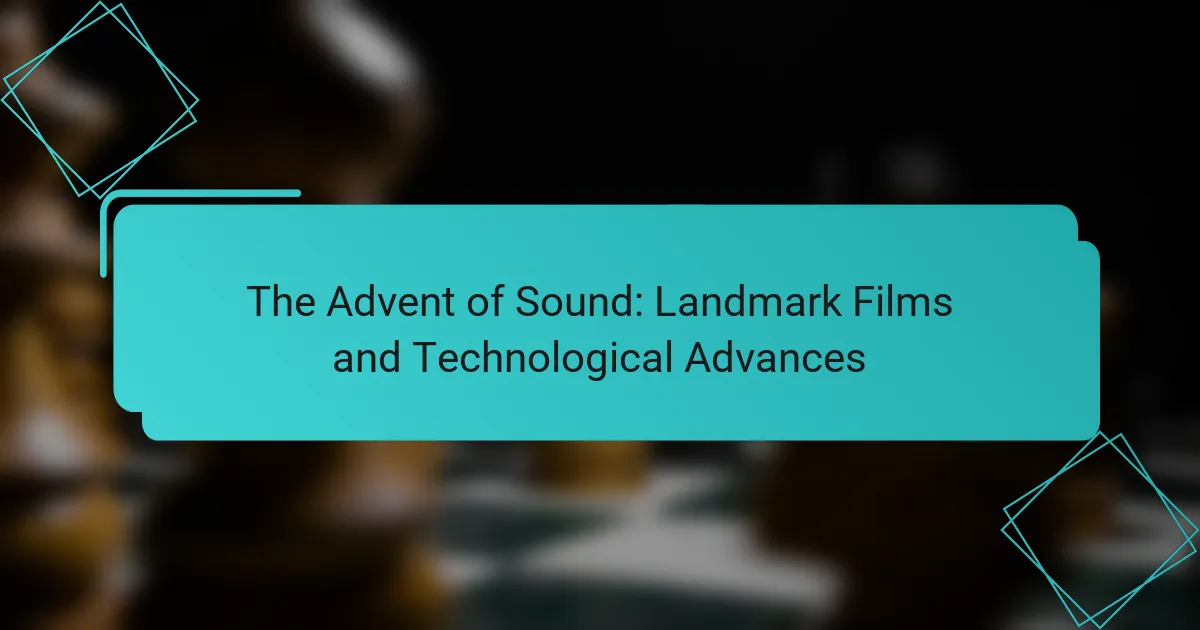The article explores the advent of sound in film, highlighting key technological advancements and landmark films that transformed the industry. It begins with the introduction of synchronized soundtracks in the late 1920s, emphasizing the significance of “The Jazz Singer” as the first feature-length film with synchronized dialogue. The article discusses the impact of innovations such as the phonograph and the Vitaphone system, which facilitated the integration of sound with visual content. Additionally, it examines how sound enhances storytelling and audience engagement, ultimately shaping cinematic experiences. The discussion includes the lasting influence of sound on narrative techniques and viewer interactions in film.

What is the Advent of Sound in Film?
The advent of sound in film refers to the introduction of synchronized soundtracks in motion pictures. This significant technological advancement began in the late 1920s. The first feature-length film with synchronized dialogue was “The Jazz Singer,” released in 1927. This film utilized the Vitaphone system, which synchronized sound with film. The success of “The Jazz Singer” marked a turning point in the film industry. By 1930, most major studios had adopted sound technology. The transition from silent films to “talkies” transformed storytelling in cinema. This shift enhanced audience engagement and expanded narrative possibilities.
How did the transition from silent films to sound films occur?
The transition from silent films to sound films occurred with the introduction of synchronized sound technology. This technology allowed dialogue and sound effects to be recorded and played back simultaneously with the film. The first successful sound film was “The Jazz Singer,” released in 1927. It featured synchronized dialogue and musical numbers, marking a significant milestone. Prior to this, films relied on live music and sound effects to accompany the visuals. The success of “The Jazz Singer” led to a rapid adoption of sound in the film industry. By the early 1930s, most films included sound, fundamentally changing cinematic storytelling. This transition also prompted changes in film production techniques and audience expectations. The era of silent films effectively ended as audiences embraced the new sound format.
What technological innovations facilitated this transition?
The transition to sound in film was facilitated by several technological innovations. The introduction of the Vitaphone system in 1926 allowed synchronized sound to be recorded on discs. This technology enabled films to incorporate dialogue and music effectively. Another key innovation was the use of optical soundtracks, which became standard in the late 1920s. This method allowed sound to be recorded directly onto the film strip. The development of sound-on-film techniques, such as the Movietone system, further enhanced audio quality. These advancements made it possible for films to deliver a more immersive experience. The success of films like “The Jazz Singer” in 1927 showcased the effectiveness of these innovations. The combination of these technologies marked a significant turning point in cinematic history.
How did audience reception change with the introduction of sound?
Audience reception shifted significantly with the introduction of sound in films. Viewers became more engaged with dialogue and musical scores. The emotional impact of scenes increased due to sound’s ability to convey mood. Audiences found it easier to connect with characters who spoke and sang. This led to a broader appeal, attracting larger and more diverse audiences. The first synchronized sound film, “The Jazz Singer,” released in 1927, exemplified this change. It marked a turning point, as it was the first to successfully integrate sound with narrative. Box office revenues soared following the introduction of sound, indicating heightened audience interest. The transition to sound also prompted filmmakers to adapt storytelling techniques, further enhancing viewer experience.
What are some landmark films that marked the advent of sound?
The landmark films that marked the advent of sound include “The Jazz Singer,” released in 1927. This film is widely recognized as the first significant “talkie,” featuring synchronized dialogue and songs. “The Jazz Singer” revolutionized the film industry and set the stage for future sound films. Another important film is “Lights of New York,” released in 1928. It was the first all-talking feature film, showcasing the potential of sound in cinema. Additionally, “The Singing Fool,” also from 1928, further demonstrated the popularity of sound films with its musical elements. These films collectively transformed the cinematic experience, leading to the widespread adoption of sound in movies.
Which films are considered the first successful sound films?
The first successful sound films are “The Jazz Singer,” released in 1927, and “Don Juan,” released in 1926. “The Jazz Singer” is often credited as the first feature-length film with synchronized dialogue. It marked a significant transition from silent films to sound films. “Don Juan” featured a Vitaphone soundtrack, but it did not have synchronized spoken dialogue. The success of “The Jazz Singer” led to the rapid adoption of sound technology in the film industry. This shift revolutionized filmmaking and audience experiences.
How did these films influence future productions?
Landmark films that introduced sound significantly influenced future productions by setting new industry standards. They demonstrated the importance of synchronized sound, which became essential in filmmaking. The success of films like “The Jazz Singer” in 1927 showcased the commercial viability of sound. This led to widespread adoption of sound technology across the industry. Filmmakers began to prioritize sound design and dialogue in their storytelling. Innovations in microphone technology and sound editing emerged as a result. Consequently, future productions adopted these advancements to enhance viewer engagement. The legacy of these films continues to shape modern cinema techniques and practices.

What technological advances contributed to the advent of sound?
The advent of sound in film was significantly influenced by several technological advances. The invention of the phonograph by Thomas Edison in 1877 allowed for the recording and playback of sound. This innovation laid the groundwork for synchronized sound in cinema. The introduction of the Vitaphone system in 1926 enabled sound to be recorded on discs and synchronized with film. This system was first used in “The Jazz Singer,” marking a milestone in sound film history. Additionally, the development of sound-on-film technologies, such as the Movietone system, further integrated audio with visual content. These advancements transformed the film industry, enhancing storytelling and audience engagement.
What were the key sound recording technologies developed during this period?
The key sound recording technologies developed during this period include the phonograph, the microphone, and the optical sound system. The phonograph, invented by Thomas Edison in 1877, allowed for the mechanical recording and playback of sound. The microphone, developed in the early 20th century, enabled sound to be amplified and captured more effectively. The optical sound system, introduced in the late 1920s, synchronized sound with film, revolutionizing the movie industry. These technologies laid the foundation for modern sound recording and playback, significantly enhancing audio quality in film and music.
How did these technologies improve sound quality in films?
Technologies improved sound quality in films by introducing synchronized sound and advanced recording techniques. Synchronized sound allowed dialogue and sound effects to match the on-screen action. This innovation transformed silent films into more immersive experiences. Advanced recording techniques, such as multi-track recording, enhanced audio clarity and depth. These techniques captured a wider range of frequencies and dynamics. The introduction of surround sound systems provided a three-dimensional audio experience. This made sound more enveloping and realistic. Historical milestones, like the release of “The Jazz Singer” in 1927, marked the transition to sound films. These advancements collectively elevated the overall auditory experience in cinema.
What role did sound mixing play in enhancing cinematic experiences?
Sound mixing plays a crucial role in enhancing cinematic experiences. It involves blending various audio elements to create a cohesive soundscape. This process includes dialogue, sound effects, and music. Each element is balanced to ensure clarity and emotional impact. Effective sound mixing can heighten suspense, evoke emotions, and immerse the audience. For example, in films like “A Quiet Place,” sound mixing is essential for building tension. The absence of sound in certain scenes amplifies the impact of sudden noises. Research shows that well-mixed audio can significantly influence audience engagement and perception of a film. Thus, sound mixing is vital for delivering a powerful cinematic experience.
How did the film industry adapt to the new sound technologies?
The film industry adapted to new sound technologies by integrating synchronized sound into films. This transition began with the release of “The Jazz Singer” in 1927, which featured synchronized dialogue and music. Filmmakers started using sound recording techniques to capture audio on set. They also developed sound stages designed to minimize external noise. The industry invested in new technologies such as the Vitaphone system for sound playback. This adaptation led to the creation of musicals and sound-driven narratives. By the early 1930s, nearly all films incorporated sound, reshaping storytelling methods. The evolution of sound technology ultimately transformed audience experiences in cinemas.
What changes were made in film production processes?
Film production processes underwent significant changes with the advent of sound technology. The introduction of synchronized sound required new recording techniques and equipment. Filmmakers needed to adapt to on-set sound recording, moving away from silent film practices. This shift also led to the development of sound stages designed for acoustics. The use of microphones evolved, with boom microphones becoming standard for capturing dialogue. Editing processes changed to accommodate sound tracks, requiring precise synchronization. Additionally, the incorporation of sound influenced scriptwriting and storytelling methods. Overall, these changes revolutionized the filmmaking landscape and enhanced audience engagement.
How did sound impact the roles of actors and directors?
Sound significantly transformed the roles of actors and directors in film. With the introduction of synchronized sound in the late 1920s, actors had to adapt their performances to include vocal delivery. This required them to focus on dialogue delivery, diction, and emotional expression through voice. Directors, on the other hand, began to emphasize sound design and audio composition in storytelling. They had to consider how sound could enhance narrative elements and character development. The film “The Jazz Singer,” released in 1927, exemplified this shift by integrating songs and dialogue, showcasing the need for actors to convey emotions vocally. This evolution also led directors to experiment with soundscapes, influencing the overall cinematic experience.

What are the lasting impacts of sound in film?
Sound in film has profound lasting impacts on storytelling and audience engagement. Sound enhances emotional depth and realism in cinematic experiences. It creates atmosphere and sets the tone for scenes. Dialogue becomes clearer and more impactful with sound. The use of sound effects adds layers of meaning to visuals. Music scores evoke specific emotions, influencing viewer reactions. Historical examples include “The Jazz Singer,” which popularized synchronized sound. This film marked a pivotal shift, leading to the dominance of sound in cinema. Overall, sound remains essential in shaping narratives and connecting with audiences.
How has sound design evolved since the advent of sound?
Sound design has evolved significantly since the advent of sound. Initially, sound in films was limited to simple dialogue and basic sound effects. The introduction of synchronized sound in the late 1920s marked a turning point. Films like “The Jazz Singer” showcased the potential of sound in storytelling.
In the following decades, advancements in technology allowed for multi-track recording and mixing. This enabled sound designers to layer sounds and create more immersive experiences. By the 1970s, films began to incorporate surround sound systems, enhancing depth and realism.
The digital revolution in the 1990s brought software tools that transformed sound editing and design. Today, sound design utilizes advanced techniques like Foley, sound libraries, and spatial audio. These innovations have made sound a crucial element in filmmaking, shaping audience emotions and experiences.
What modern techniques are used in sound design today?
Modern techniques used in sound design today include digital audio workstations (DAWs), field recording, and sound synthesis. DAWs like Pro Tools and Ableton Live allow for precise editing and mixing of audio tracks. Field recording captures real-world sounds to create authentic soundscapes. Sound synthesis involves generating sounds electronically using software or hardware synthesizers. Additionally, spatial audio techniques enhance the immersive experience in films and games. These methods enable sound designers to create complex auditory experiences that engage audiences. The adoption of these techniques is supported by advancements in technology and software capabilities.
How do contemporary films utilize sound to enhance storytelling?
Contemporary films utilize sound to enhance storytelling by creating immersive experiences. Sound design includes dialogue, sound effects, and music. These elements work together to evoke emotions and set the tone. For example, a suspenseful score can heighten tension during critical scenes. Additionally, sound effects can provide realism, making environments feel authentic. Dialogue delivery affects character development and audience connection. The use of silence can also be powerful, emphasizing moments of reflection. According to a study by the University of Southern California, effective sound design can significantly influence audience perception and engagement.
What challenges arose with the introduction of sound in film?
The introduction of sound in film presented several challenges. Filmmakers faced technical issues with sound synchronization. Early sound systems had difficulty matching audio to visuals accurately. This often resulted in noticeable delays between dialogue and lip movement. Additionally, the equipment required for sound recording was bulky and cumbersome. This limited mobility during filming and complicated production processes.
Actors also had to adapt to new performance styles. Silent film acting relied heavily on physical expression, while sound required clear vocal delivery. This transition was not easy for all performers. Audiences had mixed reactions to the initial sound films. Some viewers found the novelty exciting, while others preferred silent films.
The industry underwent significant changes as a result. Many silent film stars struggled to transition to talkies. This led to job losses and a shift in the types of films produced. Overall, the introduction of sound transformed filmmaking but came with considerable challenges.
How did filmmakers address the limitations of early sound technology?
Filmmakers addressed the limitations of early sound technology by adapting their production techniques. They used synchronized sound systems to align audio with visuals more effectively. This innovation allowed for improved dialogue clarity in films. They also incorporated sound stages to control acoustics better. Filmmakers experimented with sound effects and music to enhance storytelling. Techniques like dubbing and sound editing became essential tools. These methods helped overcome the challenges of limited recording equipment. Historical examples include “The Jazz Singer,” which showcased these advancements in 1927.
What were the cultural implications of sound in cinema?
Sound in cinema transformed cultural storytelling and audience engagement. The introduction of synchronized sound in films, notably with “The Jazz Singer” in 1927, revolutionized the film industry. This advancement allowed for more realistic dialogue and emotional depth. Audiences began to connect more deeply with characters and narratives. Sound also facilitated the incorporation of music, enhancing the emotional tone of films. The use of sound effects contributed to immersive storytelling experiences. Different cultures adopted sound in varied ways, influencing local film industries. Overall, sound in cinema bridged cultural gaps and enriched the cinematic experience.
What best practices can filmmakers learn from the advent of sound?
Filmmakers can learn several best practices from the advent of sound. First, they should prioritize dialogue clarity. Clear dialogue enhances storytelling and audience engagement. Second, sound design should complement visuals. Effective soundscapes create immersive experiences. Third, filmmakers must consider the pacing of sound. Proper timing in sound effects and music heightens emotional impact. Fourth, utilizing ambient sound can enrich scenes. Background sounds add realism and depth. Lastly, collaboration with sound professionals is essential. Experts in sound can elevate the overall quality of a film. These practices emerged as filmmakers adapted to the introduction of synchronized sound in the late 1920s. The transition from silent films to “talkies” highlighted the importance of these elements for successful storytelling.
How can understanding sound history improve modern filmmaking techniques?
Understanding sound history enhances modern filmmaking techniques by providing insights into sound design and storytelling. Historical developments in sound, such as the transition from silent films to synchronized sound, shaped audience expectations. The introduction of sound in film, exemplified by “The Jazz Singer” in 1927, revolutionized narrative techniques. Filmmakers can learn from past innovations to create more immersive experiences. Techniques like Foley sound and sound mixing have roots in early cinema practices. Knowledge of these methods allows filmmakers to enhance emotional impact in their work. Additionally, studying sound history can inspire creativity and experimentation in contemporary projects. Understanding the evolution of sound technology informs better integration of audio elements in film production.
What lessons can be drawn from the landmark films of the sound era?
Landmark films of the sound era demonstrate the importance of sound in storytelling. These films show how dialogue enhances character development. They also highlight the role of sound effects in creating atmosphere. Additionally, music scores became essential for emotional impact. Landmark films like “The Jazz Singer” marked the transition to synchronized sound. This film’s success proved that audiences embraced sound in cinema. Furthermore, these films taught filmmakers about pacing and timing with sound. Overall, the sound era reshaped cinematic techniques and audience expectations.
The main entity of the article is the advent of sound in film, a pivotal technological advancement that transformed cinematic storytelling beginning in the late 1920s. Key discussions include the introduction of synchronized sound, exemplified by landmark films such as “The Jazz Singer,” and the technological innovations that facilitated this transition, including the Vitaphone system and optical soundtracks. The article also explores the impact of sound on audience engagement, production processes, and the roles of actors and directors, as well as the lasting cultural implications and best practices derived from this significant shift in the film industry.
